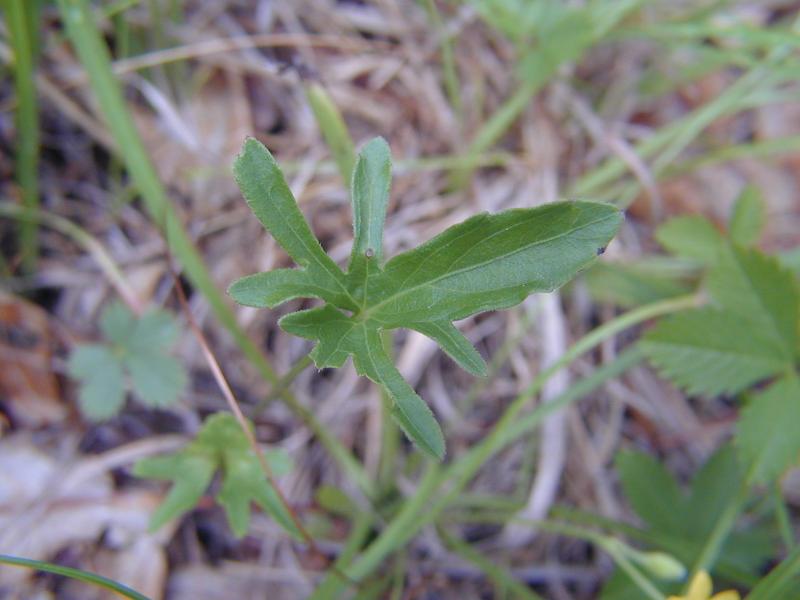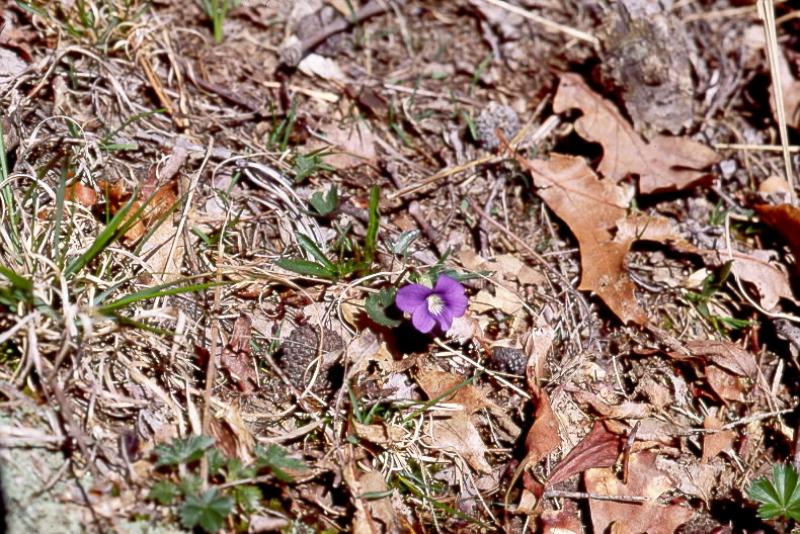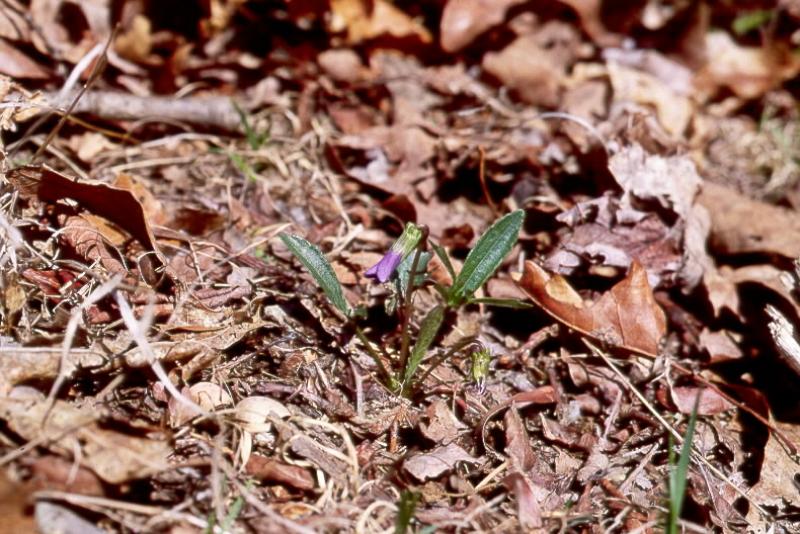Britton's Coast Violet
Viola brittoniana Pollard
- Class
- Dicotyledoneae (Dicots)
- Family
- Violaceae (Violet Family)
- State Protection
- Endangered
Listed as Endangered by New York State: in imminent danger of extirpation in New York. For animals, taking, importation, transportation, or possession is prohibited, except under license or permit. For plants, removal or damage without the consent of the landowner is prohibited.
- Federal Protection
- Not Listed
- State Conservation Status Rank
- S1
Critically Imperiled in New York - Especially vulnerable to disappearing from New York due to extreme rarity or other factors; typically 5 or fewer populations or locations in New York, very few individuals, very restricted range, very few remaining acres (or miles of stream), and/or very steep declines.
- Global Conservation Status Rank
- G4G5
Apparently or Demonstrably Secure globally - Uncommon to common in the world, but not rare; usually widespread, but may be rare in some parts of its range; possibly some cause for long-term concern due to declines or other factors. More information is needed to assign either G4 or G5.
Summary
Did you know?
The decline in numbers of this violet is very similar to the decline of the silvery aster. Once widespread on Long Island, it is now only known from one location, even though there seems to be abundant habitat left.
State Ranking Justification
There is only one existing population of less than 50 plants. This was once more widespread on Long Island with 30 historical records, but most of them have been extirpated by development.
Short-term Trends
Succession at its only location may be causing the population to decline.
Long-term Trends
This was once more widespread on Long Island with 30 historical records but most of them have been extirpated by development.
Conservation and Management
Threats
The remaining population is threatened by trail maintenance that allows too much succession. Historical populations were threatened and extirpated by development of open habitats, failure to contain exotic plant invasions and lack of fire management.
Conservation Strategies and Management Practices
This species needs disturbance to reduce competition from woody plants or more aggressive herbaceous plants, but too much direct disturbance to the plants will reduce or eliminate the population. Its habitat could be disturbed in the non-growing season to open it up for seed germination and colonization, but direct disturbance should be prevented during the growing season. A management plan is needed at its current location.
Research Needs
Research is needed to determine the best management strategy to augment the existing population. Plants should be grown in the greenhouse to preserve the genetic stock, and studies should be done to evaluate reintroduction sites on Long Island.
Habitat
Habitat
The only extant site for Coast Violet in New York is along trails and roadsides in a wet pine barrens. It was previously collected from a sandy Long Island grassland (New York Natural Heritage Program 2010). Moist sandy woods and flats (Rhoads and Block 2000). Well drained soil in woods, clearings and glades (Gleason and Cronquist 1991). Sandy or peaty soil (Fernald 1970).
Associated Ecological Communities
- Hempstead Plains grassland
(guide)
A tall grassland community that occurs on rolling outwash plains in west-central Long Island. This community occurs inland, beyond the influence of offshore winds and salt spray.
- Mowed roadside/pathway
A narrow strip of mowed vegetation along the side of a road, or a mowed pathway through taller vegetation (e.g., meadows, old fields, woodlands, forests), or along utility right-of-way corridors (e.g., power lines, telephone lines, gas pipelines). The vegetation in these mowed strips and paths may be dominated by grasses, sedges, and rushes; or it may be dominated by forbs, vines, and low shrubs that can tolerate infrequent mowing.
- Pitch pine-scrub oak barrens
(guide)
A shrub-savanna community that occurs on well-drained, sandy soils that have developed on sand dunes, glacial till, and outwash plains.
Associated Species
- Clethra alnifolia (coastal sweet-pepperbush)
- Danthonia
- Dichanthelium
- Gaultheria procumbens (wintergreen, teaberry)
- Hypericum canadense (lesser Canadian St. John's-wort)
- Hypoxis hirsuta (yellow star-grass)
- Juncus tenuis (path rush)
- Plantago major (common plantain)
- Potentilla
- Pteridium aquilinum
- Rhynchospora capillacea (hair beak sedge)
- Rubus hispidus (swamp dewberry)
- Schizachyrium scoparium
- Viola primulifolia
Range
New York State Distribution
This violet was historically common from Westchester County south through New York City to Eastern Long Island. Its habitat has been greatly reduced and it is currently known only from Central Long Island. It is probably extirpated from Nassau County to the west.
Global Distribution
This violet occurs on the Atlantic Coastal Plain from Eastern Massachusetts south to Northern South Carolina.
Identification Comments
General Description
Viola brittoniana is a perennial wildflower species. The leaves are glabrous and deeply palmately divided nearly to the base, then again divided into slender lobes. It is a "stemless" violet, meaning that the flowers are borne singly on leafless stalks emerging directly from the base of the plants. The petals are purple, the lateral ones "bearded" inside with long thread-like hairs. The sepals are lance-shaped, coming to a point at the apex. The fruit are green, long egg-shaped capsules containing brown seeds 1.3 to 1.5 mm long, held on erect peduncles (Rhoads and Block 2000, Haines 1998).
Best Life Stage for Proper Identification
Flowering or fruiting individuals are needed for identification.
Similar Species
V. palmata and V. subsinuata are two violet species closely related to Viola brittoniana. Viola palmata differs from V. brittoniana by having leaves divided only halfway to their bases, and seeds 2 mm long on prostrate peduncles. V. subsinuata has hairy leaves, divided only halfway to their bases, beardless bottom petals, and purple-spotted fruit on short prostrate peduncles.
Best Time to See
Coast Violet flowers from May through June, and the fruits may persist into September.
- Vegetative
- Flowering
- Fruiting
The time of year you would expect to find Britton's Coast Violet vegetative, flowering, and fruiting in New York.
Britton's Coast Violet Images
Taxonomy
Britton's Coast Violet
Viola brittoniana Pollard
- Kingdom Plantae
- Phylum Anthophyta
- Class Dicotyledoneae
(Dicots)
- Order Violales
- Family Violaceae (Violet Family)
- Order Violales
- Class Dicotyledoneae
(Dicots)
- Phylum Anthophyta
Additional Common Names
- Coast Violet
Synonyms
- Viola brittoniana var. brittoniana
- Viola brittoniana var. pectinata (Bickn.) Alexander
- Viola palmata L. [in part.]
Comments on the Classification
Includes var. pectinata as a synonym. This taxon is a good entity although it may be listed as a variety by some researchers.
Additional Resources
References
Fernald, M.L. 1950. Gray's manual of botany. 8th edition. D. Van Nostrand, New York. 1632 pp.
Gleason, Henry A. and A. Cronquist. 1991. Manual of Vascular Plants of Northeastern United States and Adjacent Canada. The New York Botanical Garden, Bronx, New York. 910 pp.
Haines, A. and T.F. Vining. 1998. Flora of Maine, A Manual for Identification of Native and Naturalized Vascular Plants of Maine. V.F.Thomas Co., Bar Harbor, Maine.
Holmgren, Noel. 1998. The Illustrated Companion to Gleason and Cronquist's Manual. Illustrations of the Vascular Plants of Northeastern United States and Adjacent Canada. The New York Botanical Garden, Bronx, New York.
New York Natural Heritage Program. 2010. Biotics database. New York Natural Heritage Program. New York State Department of Environmental Conservation. Albany, NY.
New York Natural Heritage Program. 2024. New York Natural Heritage Program Databases. Albany, NY.
Rhoads, A.F. and T.A. Block. 2000. The Plants of Pennsylvania: An Illustrated Manual. University of Pennsylvania Press: Philadelphia, Pennsylvania. 1061 pp.
Russell, Norman H. (1965). Violets (Viola) of central and eastern United States: An introductory survey. Sida 2(1):1-113.
Weldy, T. and D. Werier. 2010. New York flora atlas. [S.M. Landry, K.N. Campbell, and L.D. Mabe (original application development), Florida Center for Community Design and Research http://www.fccdr.usf.edu/. University of South Florida http://www.usf.edu/]. New York Flora Association http://newyork.plantatlas.usf.edu/, Albany, New York
Links
About This Guide
Information for this guide was last updated on: April 11, 2011
Please cite this page as:
New York Natural Heritage Program. 2024.
Online Conservation Guide for
Viola brittoniana.
Available from: https://guides.nynhp.org/coast-violet/.
Accessed July 26, 2024.


